

|
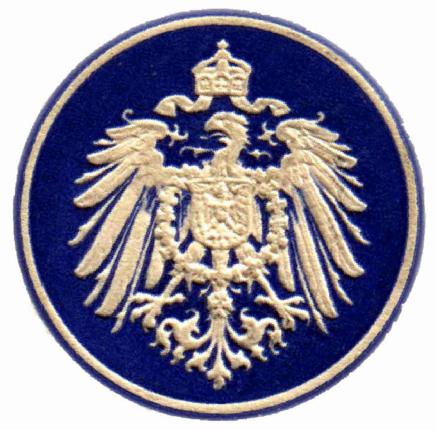
|
Postage Stamps used in the German Marshall Islands 6 –Eagle Issues by Dirk H.R. Spennemann |
Essays —
Issue "Marschall Inseln" —
Issue "Marshall Inseln" —
Sheets and Selvedges |
|
|
| The first German stamps specifically made for the Marshall Islands were standard German Eagle stamps with the overprint Marschall-Inseln. Their origin goes back to the mid 1890s when the German Colonial Advisory Group ('Kolonialrath') exerted pressure on the German government to follow British, French, Spanish and Portuguese examples and to issue special stamps for each of the German colonies and protectorates. The Imperial German Post Service moved in late 1896 or very early in January 1897 to do so. One of the reasons given by the postals service was to clearly identify the origin of the mailed letters if the cancels were smudged, the other was the fact that for postal purposes the colonies were foreign mail and required foreign mail rates. Several essays and formal issues of Eagle series stamps were produced for the Marshall Islands. Apart from the initial essays can distinguish two plates with an overprint reading "Marschall Inseln" and one with the overprint reading "Marshall Inseln." These are discussed below. |
|
Essays
|
|
The initial tests considered various types of overprints over the standard Eagle series definitives. In 1893 the German post office had experimented with various shaped overprints for its German East Africa issues settling on a large number and value overprint for its 1893 issue. By 1896, when the currency in German East Africa had been switched from Pesa to Imperial German currency, a new overprint was used, consisting of the colony's name set diagonally from bottom left to top right. This design, which was to form the template for other colonial issues, was preceded by elaborate testing of other varieties.[1] |
|
Marschall Inseln
|
| For the discussion of the issue overprinted 'Marschall Inseln' we have to distinguish between four different variations: the Berne Issue, the Jaluit Issue ('Schalterausgabe') and the original Berlin issue ('Berliner Urdruckausgabe'), all of which were made from the first plate, and the Berlin reprint issue ('Berliner Neudruckausgabe'), made from the specifically made third plate.[2] |
| Proofs In January 1897 the Imperial printery overprinted one (or two) sheets of 100 stamps of each of the six denominations deemed suitable for the colonies: 3Pfg, 5Pfg, 10Pfg, 20Pfg, 25Pfg and 50Pfg. The essays were printed as two strips of five colony names per row. Printed were stamps for (in sequence from left to right) German New Guinea, German South-West Africa, Marshall Islands, Togo and Kamerun. Unlike the final production run, where the Marschall-Inseln overprint was set at an angle of 56 degrees, the proof issues hat overprints set at an angle of 45 degrees (similar to the final product for the Caroline Islands). This angle, however, was too shallow to allow for an adequate display of the colony's name, and for the Marshall Islands alone a steeper angle was adopted. [3](see also catalogue). Later this steeper angle was adopted for all colonies. |
| Berne Issue To comply with the regulations of the World Postal Union, in February 1897 the German government printed 800 sets of all stamps (3, 5, 10, 20, 25 and 50 Pfennig). 760 of the sets were delivered to Berne (Switzerland) while the remaining 40 sets went to the Imperial Post Museum. The sets delivered to Berne were to be distributed to the member states as samples. While such samples were commonly overprinted 'Specimen, ' this was not feasible in this instance, if the overprint 'Marschall-Inseln' was not to be obscured. Thus the stamps sent were actual and valid stamps. Some of these sets found their way into the stamp trade and were acquired by collectors. Some were sent on self-addressed letters to Jaluit, where they were cancelled on request.[4](see also catalogue). |
| Jaluit Issue or 'Schalter-Ausgabe' The first poduction stamps with the overprint Marschall-Inseln were printed in Berlin between 15 and 20 February 1897 and became available in Jaluit from 10. April 1897 onwards.[6] (see also catalogue). Because the Marshall Islands had only a single post office, the only German colony with that peculiarity, there was no need to produce 3 Pfennig stamps. Likewise 25 Pfennig stamps had not been issues among the Vorläufer series. Past experience of postal use in the Marshalls allowed to estimate the quantities needed. For example the use of the 5 Pfg and 50 Pfg had been low and by the end of 1896 substantial stocks of not overprinted stamps were held in Jaluit (1012 and 985 respectively).[7] It is possible that the 20 Pfenning stamps were not issued until 28 May 1897, at the same time when the 10Pfg postal stationary was issued over the counter. There are also suggestions that the 10 Pfennig values were not available for sale until September 1897. Both delays were caused by the large remaining holdings of non-overprinted stamp stock.[8] Over time the post office in Jaluit ordered further stock from the postal directorate Hamburg ('Oberpostdirektion Hamburg'), which in turn ordered standard Eagle series stamp stock of the day to be oveprinted. This practice led to variations in appearance of the stamps, particularly the 3 Pfenning brown which exists in several shades (see catalogue). The dates of delivery of the stamp issues to Jaluit are set out in a table further below. The main values shipped and used were the 10 Pfg and the 20Pfg which were still in ample suply in November 1899, largely due to low mail volume caused by the erratic mail connections at the time. To cater for a possible change in demand caused by the introduction of domestoc mail rates effective 1 May 1899, Jaluit was also supplied with 3 Pfg and 5 Pfg stamps. These were despatched on 14 April 1899 and counted in on 2 September 1899. These values found use only very rarely, because the postal rates used were those of the World Postal Union and little if any printed matter for which 3Pfg stamps would have been needed, originated in and was sent within the Marshall Islands.[9] |
 |
 |
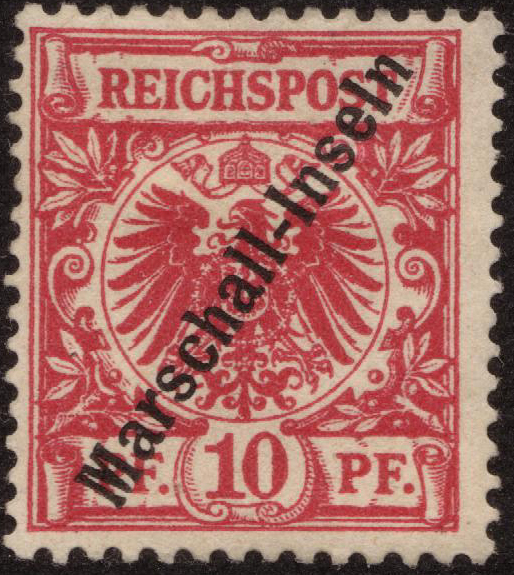 |
| 3 Pfennig | 5 Pfennig | 10 Pfennig |
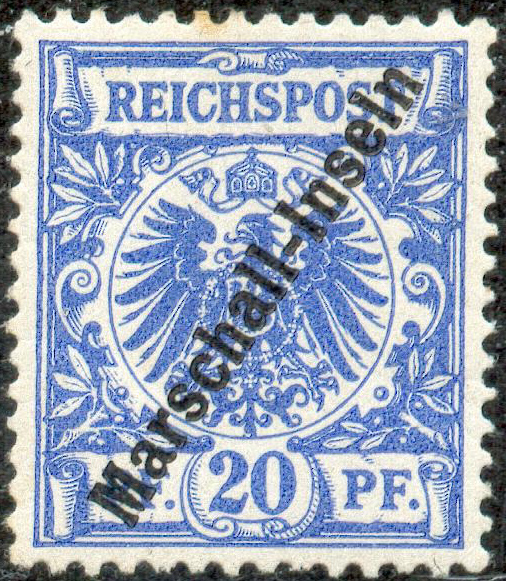 |
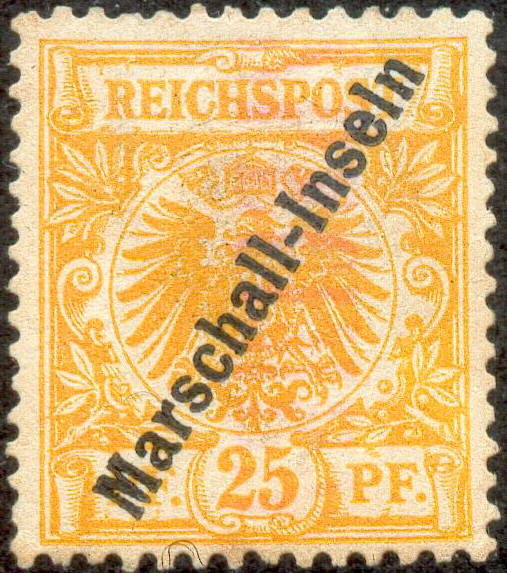 |
|
| 20 Pfennig | 25 Pfennig | 50 Pfennig |
General images of the six values of the Marschall Inseln Issue | ||
| While the Imperial post had large quantities of 10 Pfg and 20Pfg stamps printed, the demand for 3 Pfg stamps was seen as low, and only 1,000 were produced. Of the 5 Pfg stamps 2,000 were printed. There is an acount that states that the 3Pfg and 5Pfg stamps were available for sale in Jaluit from 21 July 1899 onwards.[11] It would appear that for some months the 3 Pfg stamps were available and were used in small quantities, mainly by people with philatelic interests, who used them to frank letters to friends and business acquaintances.[12] The former postmaster Knoth is on record as recollecting that he sold many of the stamps to local parties, as they were a nuisance to him.[13] These stamps were reputedly sold out on or before 27 November 1899. At least a large order placed by the Germania Ring through the offices of the Jaluit Gesellschaft, could not be filled (see here for the correspondence between the Post Office and the Jaluit Gesellschaft).[14] |
| Large numbers of the 1000 3Pfennig stamps supplied to Jaluit never made it to the counter, but were acquired for speculative purposes by the German postal agent's father-in-law, German traders (Hütter; Mittel, Jentsch, Petersen, Krümling) and other colonial administrators, among them apparently the German administrator (Landeshauptmann), Eugen Brandeis.[16] The stamps, approximateky 900, were stuck on sheets of paper, as well as grey envelopes, and cancelled to order. The CTO cancels can be recognised by their perfect and well-centered appearance.[17] Contemporary sources estimate that only 100 of the 1000 3 Pfg stamps supplied remained unused, and of these only about 70 actually ended up in collections [of these 70 there are three block of four and 2 pairs]. 32 of these stamps were acquired by the Germania-Ring and bear on the reverse the expertise mark of the Germania-Ring [GR] in in red-violet ink.[18] A major concern to the stamp collectors was the colour shade of the stamp, as this seemingly allowed to distinguish these from the Berlin issue. The colour was originally light yellowish brown, but which due to tropical influences has discoloured to a yellow-brown. Also much debate occurred as to whether the stamps had a white or a yellow gum.[19] Friedemann could show that the tropical influences indeed changed to colour of gum as well as that of the paper.[21] A large number of 5Pfg stamps were also used on picture/view cards, which were sent between people on Jaluit. Given that only one post office existed, and that the entire islad of Jabwor, Jaluit, where the Europen residences were concencrated, was not more than 1.5 km long and about 1 km wide these card too were pure philatelic machinations to create 'real' items for a future market.[22] A large number of stamps of the first issue, especially the lower, and thus cheap denominations, were removed from the normal stamp trade and hoarded. The contemporary philatelic press accused the postmaster Carl Domnick of such actions.[23] |
| Quantities of stamps sent to Jaluit [24] | ||||
|---|---|---|---|---|
| Issue | Value | Date arrived | Date on sale | Quantity |
| sch | 3 Pfg | 10 April 1899 (c) | 21 July 1899 | 1,000 |
| sch | 5 Pfg | 10 April 1899 (c) | 21 July 1899 | 2,000 |
| sch | 10 Pfg | mid 1897 | August 1897 | 4,000 |
| sch | 10 Pfg | mid 1897 | September 1897 | 10,000 |
| sch | 10 Pfg | 10 April 1899 ? | 21 July 1899 | 2,000 |
| sch | 20 Pfg | early 1897 | April 1897 | 1,000 |
| sch | 20 Pfg | early 1897 | 21 May 1897 | 4,000 |
| sch | 20 Pfg | mid 1897 | September 1897 | 10,000 |
| (c) counted at Berlin ("eingezählt") | ||||
| The estimated disposal (mint or cancelled) of the total run of stamps of the first issue is as follows: |
| Estimated disposal of first issue ('sch') stamps at Jaluit [26] | |||
|---|---|---|---|
| Value | No. delivered | estimated mint | estimated cancelled |
| 3 Pf | 1,000 | ~100 | ~900 |
| 5 Pf | 2,000 | ~900 | 1,100 |
| 10 Pf | 16,000 | ~6,000 | ~10,000 |
| 20 Pf | 10,000 | ~5,000 | ~5,000 |
| 25 Pf | not delivered to Jaluit | ||
| 50 Pf | not delivered to Jaluit | ||
| At the time of the arrival of the new stamp stock with the 'Marshall Inseln' overprint, the old stock was counted and reported to Hamburg. On 1 November 1899 the Jaluit Post Office still held 10,773 10 Pfennig. 9,751 20 Pfenning stamps, but none of the 3 Pfennig and none of the 5 Pfennig. In addition, 248 non-overprinted 50 Pfg Eagle issue stamps were on stock.[27] Philatelically created demands on the 5 Pfenning issues led to the creation of bisected stamps. The 10 Pfg and 20 Pfg values of the 'Marschall Inseln' overprints remained for sale at the Jaluit Post Office until March or April 1900.[28] |
| With the commencement of domestic postal rates from 1 May 1899 onwards, larger amounts of 5 Pfg were sent and accessioned on 10 April 1899. These were used up by 28 November 1899 and were replaced by stamps of the second issue with the overprint Marshall Inseln which had just arrived (on 24 November 1899). In addition, larger numbers of preprinted 5Pfg postal stationary was used compared to the 10 Pfg cards used until then.[29] The old Marschall Inseln were used up over time, which took about 6 months. During that time mixed frankings of sch and sh stamps could have occurred in normal postal practice. |
| According to contemporary discussion the other values (3Pfg, 25Pfg and 50Pfg) remained essays and were never formally issued in Jaluit.[31] The same source already indicates that it might have been possible that 3Pfg stamps were actually available at the Jaluit Post Office.[32] In late September 1899 these stamps were withdrawn and replaced with stamps with an overprint reading Marshall Inseln. This correction was in line with an order by the German Foreign Office to ensure that the original name was retained in favour of the Germanicised spelling.[33] |
| A sizeable number of covers, philatelically franked with Berne variety stamps, as well as stamps that were available for sale in Berlin, but not Jaluit were sent by the 'Germania-Ring' as well as a stamp dealer to Jaluit and put through the mail. The number of covers thus created, exceeds 200. Most of the covers carry a 1899 cancel. The second issue (Sh) was also sent on covers to Jaluit, with cancels bearing the date 1900.[34] |
| Original Berlin Issue ('Berliner Urdruckausgabe') In 1898 another set of samples was printed, comprised of 2 sheets of each value of each of the colonies. These stamps were destined for internal postal education and reference use only and were handed to the Imperial Postal Museum, which could use some of them for exchange and trading purposes.[36] Based on colour variations appears that these stamps could not have been printed before December 1897, even though the contemporary philatelic press at first assumed a printing date of March 1897.[37] (see also catalogue). |
| Berlin Reprint Issue ('Berliner Neudruckausgabe') The German Postal Service supplied the Berlin stamp dealer Philipp Kossack with 4428 sets of these stamps for sale, as a trade for varieties required for the national stamp collection. Kossack had offered the Imperial German Postal Museum a good collection of Schleswig-Holstein stamps valued (then) between 10,000 and 15,000 Marks. In September 1899 Kossack requested a large quantity of Marschall Inseln' overprint stamps which had just been replaced by the new Marshall Inseln' issue. Kossack could rightfully anticipate that the demand for the Marschall overprints would increase. As the old printing plate had been destroyed, the Imperial German stamp printery mande a new one vased on samples of overprinted stamps. Careful inspection shows that the overprints occur in fine, medium and fat letter impressions. The first batch of prints from the new plate, comprising 2500 sets as well as sets of postal stationery, was printed in November 1899 using type D perforated sheets of paper. (see also catalogue). As such they were not a new print run, but new prints, made after the second sh Eagle issue had been printed and a new plate had been made.[38] Kossack sold 1000 sets each to the Leipzig stamp dealers Gebrüder Senf, as well as the Berlin stamp dealer Ernst Stock. Kosack, Senf and Stock offered these stamps for sale as early as December 1899.[39] A second batch of overprints was offered during 1903. It had been speculated that this represented yet another reprint, possibly using an old plate,[41] but an analysis of small varaitions in the overprints showed that they were made from the same printing plate.[42] Unlike the first batch, these were printed on a variety of other page formats, namely types A,, C and particularly E. Wittmann has argued that the changes of sheet types as the use of different of the original stamp stock represents repeated reprinting over a short period which required repeated adjustment of the printing plates. This could have led to the excessive but differential wear of the plates. He also assumes the odd number of sets (1928) suggests that a round number would have been printed, either 2000 or 2500. The remaining stock was assumed to have been given to the Imperial Post Museum.[43] (see also catalogue). |
| The contemporary stamp press was incensed at the behaviour exhibited by the Imperial German Postal Museum and wondered how to classify the stamps, particularly those, that then entered the mail system as part of philatelic covers. The pages of the stamp magazines are full of discussion on the matter.[44] The matter was not helped by the fact that the Imperial Post Office declared on 28 April 1903 that such new prints were never made.[46] Others argued that the nature of the new overprints, which gave fine, middle and fat/bold prints (see below), not oly implied that a large number had been reprinted but that, furthermore, new printing plates had been made to allow for the fine and crisp variety to occur. This then led to a widespread condemnation of the German Postal Services practices,[47] as well as the Germania-Ring requesting formal legal advice on the matter.[48] The earliest date these Berlin reprint stamps may have reached Jaluit is January 1900.[49] The philatelic trader Philipp Kossack, for example, managed to sent 150 complete sets of the first batch to Jaluit for cancellation and return delivery through the mail system. These covers are all addressed with a preprinted address to "Philipp Kossack in Berlin C2, Burgstr. 8." All these covers can be distinguished even of the stamps were cut out as individual stamps on paper by their weak yellow-greenish paper. All complete Kossack covers carry printed Registration labels of the 'old' type (Jaluit (Marschall-Inseln) with registration numbers around 160-178 (+/– 150), cancels with the date 31 / 3 00 and arrival stamps "Berlin 20. 8.00." In addition, Kossack had sent another batch of covers to Jaluit, at least 50 covers, which were submitted via the Geheimer Oberpostrat Hennicke, the curator of the Imperial Post Museum in Berlin. These covers, on white paper, carry the handwritten address "Einschreiben! An das Reichs-Postmuseum. Berlin W." The same registration labels were used (with No 39 and nearby numbers). They too were cancelled 31 / 3 00 and also 21 / 3 00.[51] It later on transpired that the German postal service directed the postmaster in Jaluit to cancel the covers, even though he reputedly questioned both the use of the 25Pfg and 50Pfg stamps (which had never been issued in Jaluit), as well as the use of 3Pfg stamps with a very dark brown shade, which did not compare to his own sample set.[52] |
| In 1908 the Imperial Post Office declared that a total of 4428 sets was traded with onestamp dealer.[53] Ohrt as well as Friedemann could show that the Berlin issue actually comprised of two deliveries, a newly printed set of 2500 stamps of each denomination, as well as 1928 sets which he believed had derived from old stock, which printed during the normal printing period (1897 to mid 1899).[54] As mentioned earlier, it is now assumed that the variations between the first and the second lot were caused by differential wear and continual resetting to accommdate different sheet formats. An analysis of the printing flaws of the first and the third plate showed that the medium and fat overprints also were made suing the third printing plate.[56] |
| Distinguishing the Berlin Reprint Issue The Berlin Reprint Issue can be distinguished from the Berne and Jaluit issues by its clear white gum (when mint), the printing colours, the paper, the dates and the type of cancel used. Original, genuine Berne and Jaluit issues would be cancelled with a type I cancel with the years 1897, 1898 and 1899. The genuine 3Pfg and 5Pfg stamps, which became available in June 1899, can be identified by their cancel dates. Most of them are cancelled 21/7/99; 25/8/99; 29/10/99; 28/11/99; 2/12/99 and 15/12/99.[57] | ||
 Type I Cancel |
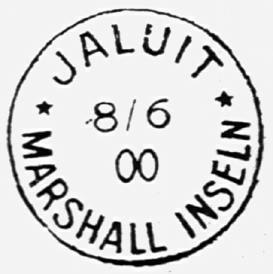 Type II Cancel |
Berlin issue stamps carry the type I cancel with dates of 21/3/00 and 31/3/00, as well as type II cancels with various dates of 1900. Because the type II cancel was first used between 23 and 27 May 1900, genuine 3Pfg and 5Pfg cancels of the Jaluit issue cannot have occurred. This cancel, however, can have been genuinely used on 10Pfg and 20Pfg stamps. Stamps of 25Pfg and 50Pfg were never issued in Jaluit and always suspect. A few Berne issue stamps were sent to Jaluit as part of philatelic covers, but they are are deemed unlikely to show up as single cancelled stamps. |
|
The type II cancel has also been used to cancel Eagle Issue stamps (both sch and sh) even after they were recalled from use. This was done by backdating the cancel. It must be understood that a genuine canceller was used, ie that this must have occurred by someone with access to the post office. The contemporary stamp press suspects Felix Becker, father-in-law of the postmaster Carl Domnick, with, or without the latter's collusion. The backdated cancels are recognisable by a different cancel colour (deep black and oily-sooty appearance instead of a black or grey-black and dry/crisp appearance) and a number of cancel dates. Suspect dates are set out here.[58] |
| Strength of overprint: It was observed early on that the new prints came in three strengths of overprints: 'fine,' 'middle' and 'fat / bold.' Occaisonally authors even distiguish a fourth variety inbetween 'middle' and 'fat.' The problem rests in the fact that slight variations in the strength of inking the printing plates led to different overprints, as did the wear and tear of the plates. (see catalogue) |
| Paper variations: Viewed under UV light, the paper of all Berlin reprints appears greyish-violet to weak violet, while the paper of the Jaluit Issues appears white to yellowish.[59] |
| Colour variations: It was observed that some of the colours, particularly of the 3 Pfg were subject to change due to the tropical conditions. The Jaluit-Issue 3 Pfg was of a yellowish-brown colour when delivered to Jaluit. After a few months in Jaluit the colour changed to a reddish-brown. The Berlin reprints, however, are dark brown and were not subject to colour change, nor were the stamps of the Marshall issue. Some colour variations are displayed on separate page.[61] The 5 Pfennig stamps exist both with white gum and a light yellowish brown gum, which due to tropical influences discoloured to a yellow-brown. While the latter was unique to the Jaluit issue, stamps with white gum were both supplied to jaluit and formed the basis for the Berlin reprint issue. According to Wittmann a distinction can be made under UV light, where the colour of the Jaluit Issue is green, while the colour of the Berlin reprints is blackish-green.[62] The 10 and 20 Pfennig stamps exist both with white gum and a light yellowish brown gum, which due to tropical influences discoloured to a yellow-brown. Here a colour differentiations are not easily possible. All those 10 Pfg stamps which appear bright red under UV light are Berlin Reprints.[63] |
| Damage to and variations of the printing plates: P.Ohrt conducted a detailed anaylsis of Kossack's Berlin issue on a complete sheet of each of the values and found a number of plate variations, which carry through to all values. The variations are set out below, with reference to the stamp on the sheet. As the stamps are set out 10 across and ten down, they are counted in horizontal rows from top left. Thus the first stamp in the second row would be in position 11, while the fifth stamp in row six would be in position 65.[64] |
| Distinguishing marks of some of the Berlin issue prints [66] | ||
|---|---|---|
| Position | Damaged letter | Description |
| 1 | c | The upper arc of the 'c' does not end in the same line thickness as the rest of the letter but tapers to a fine end. Compared to the Jaluit Issue the arc of the 'c' is also flatter and less semicircular. |
| 34 | n | A fine white line (hairline) goes through the second vertical bar of the 'n' |
| 41 | n (last) | The second vertical bar of the 'n' dos not end horzontally but obliquely |
| 41 | r | The top dot has a wedge shaped damaged to the right end |
| 41 | s | damage |
| 46 | h | The second vertical bar of the 'h' has a constriction in the upper part and widens in the lower part, giving the impression that the space bounded by the 'h' appears o-shaped |
| 56 | h | The second vertical bar of the 'h' has a constriction in the upper part and widens in the lower part, giving the impression that the space bounded by the 'h' appears o-shaped |
| 59 | h | The second vertical bar of the 'h' has a constriction in the upper part and widens in the lower part, giving the impression that the space bounded by the 'h' appears o-shaped |
| 60 | l (last) | damage |
| 60 | M | damage |
| 62 | h | A fine white line goes through the second vertical bar of the 'h' |
| 62 | r | The upper part of the head of the 'r' is missing, as if it had been removed |
| 87 | r | damage |
| 88 | h | damage |
| 90 | h | damage |
| 90 | ll | (Only recognisable on clear impressions of light-coloured stamps). The right side of the left 'l' is thinner, giving the letter a tapering appearnce, and the letter combination 'll' the appearance of an 'x'. Als, the right bottom serif of the left 'l' is also lacking. |
| 90 | n | damage |
| 95 | s (first) | The upper arc of the 's' has a vertical white line, separating the serif-end from the arc. This results in the impression that the upper arc of the 's' ends in a dot. |
The last run of Eagle series stamps was printed on 10 August 1900 (a supply of 3 Pfg Karolinen stamps). The printing of the new Yacht series stamps commenced on 13 August 1900.[67] The Eagle series stamps of both the Marschall-Inseln and the Marshall-Inseln issues remained valid until 30 September 1901, after which only Yacht series stamps were legal postage.[68] |
| Estimated quantity of mint and cancelled Eagle series stamps [69] | ||||||||||||
|---|---|---|---|---|---|---|---|---|---|---|---|---|
| 3 Pfg | 5 Pfg | 10 Pfg | 20 Pfg | 25 Pfg | 50 Pfg | |||||||
| Issue | * | o | * | o | * | o | * | o | * | o | * | o |
| Berne | 800 | -- | 800 | -- | 800 | -- | 800 | -- | 800 | -- | 800 | -- |
| Jaluit | 70 | 930 | 1000 | 1000 | 10000 | 6000 | 1000 | 6000 | -- | -- | -- | -- |
| Berlin- Originals | 199 | 1 | 199 | 1 | 199 | 1 | 199 | 1 | 199 | 1 | 199 | 1 |
| Berlin–Reprints Batch I | 1800 | 700 | 1800 | 700 | 1800 | 700 | 1800 | 700 | 1800 | 700 | 1800 | 700 |
| Berlin–Reprints Batch II | 1600 | 328 | 1600 | 328 | 1600 | 328 | 1600 | 328 | 1600 | 328 | 1600 | 328 |
| TOTAL | 4270 | 1958 | 5200 | 2028 | 14200 | 7028 | 14200 | 7028 | 4200 | 1028 | 4200 | 1028 |
|
Marshall Inseln
|
| The first consignment of overprinted issues of the standard German Eagle stamps with the overprint Marshall-Inseln was received on Jaluit on 2 September 1899, first sold on 27 September 1897 and first cancelled the day after.[72] This series is distinguished from the previous one by the omitted 'c' in the Marshall Islands overprint. Unlike the stamps for the Caroline and the Mariana Islands, only one angles of overprint is on record, set at 48 degrees (see also catalogue). |
| The demand for the stamps, particularly the lower values was very high, necessitating repeated re-ordering from Hamburg, which in turn required repeated printing in Berlin. This led to variations in the overprint and the colour of some of the base stamps. In total 68,300 3Pfennig and 50,300 5 Pfenning stamps were issued in Jaluit between September 1899 and September 1900.[74] |
| The Marshhall-Inseln issue was withdrawn from sale when the new Yacht Issue was made available. The Yacht stamps were available in Berlin from 7 December 1900 onwards while the Jaluit Post Office had the Pfennig values from January 1901 and the Mark values from March 1901. The Marshhall-Inseln issue, as well as an remaining stamps of the Marschhall-Inseln issue were withdrawn as legal postage tender on 30 September 1901 (as in the case of the Mariana Islands stamps).[76] |
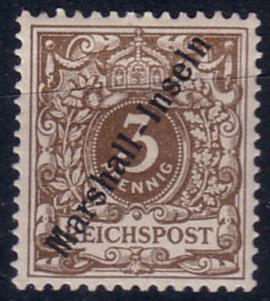 |
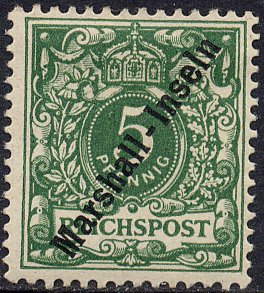 |
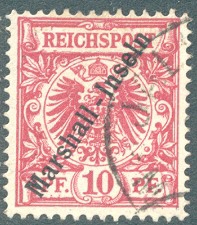 |
| 3 Pfennig | 5 Pfennig | 10 Pfennig |
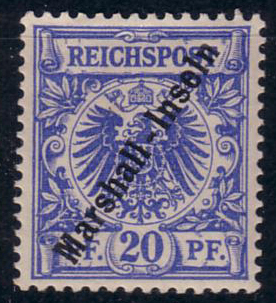 |
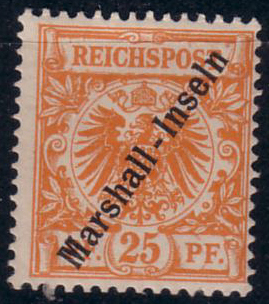 |
 |
| 20 Pfennig | 25 Pfennig | 50 Pfennig |
General images of the six values of the Marshall Inseln Issue | ||
| Quantities of stamps sent to Jaluit [73] | ||||
|---|---|---|---|---|
| Issue | Value | Date arrived | Date on sale | Quantity |
| sh | 3 Pfg | 2 September 1899(c) | 24 November 1899 | 2,000 |
| sh | 5 Pfg | 2 September 1899(c) | 24 November 1899 | 2,000 |
| sh | 10 Pfg | 2 September 1899(c) | 24 November 1899 | 4,000 |
| sh | 20 Pfg | 2 September 1899(c) | 24 November 1899 | 4,000 |
| sh | 25 Pfg | 2 September 1899(c) | 24 November 1899 | 2,000 |
| sh | 50 Pfg | 2 September 1899(c) | 24 November 1899 | 2,000 |
| sh | 10 Pfg | early 1900 | unknown | unknown |
| sh | 20 Pfg | early 1900 | unknown | unknown |
| (c) counted at Berlin ("eingezählt") | ||||
| Proofs Just as had occurred in January 1897 the Imperial printery overprinted two)sheets of 100 stamps of each of the six denominations deemed suitable for the colonies 3Pfg, 5Pfg, 10Pfg, 20Pfg, 25Pfg and 50Pfg with the new steep angle overprints. As the stamps cannot be distinguished from the issued ones, these proofs can only be identified as setenant pairs. The Marshalls stamps can occur as couplets or triplets, with 'Samoa' attached at the left, 'Karolinen' at the right and 'China' at the bottom.[78] (see also catalogue). |
|
In addition to the stamps as issued, standard Imperial German Eagle Issue stamp occasionally occur with colonial postmarks. This use was legal, but normally frowned upon. An example is the 20 Pfennig Eagle stamp shown at left, which is cancelled 13 February 1901. Common are 2Pfg Eagle series stamps which are placed on envelopes as Mitläufer, usually to create philatelic variation.[77] |
|
Sheets and Selvedges The Pfennig stamps were set out in sheets of 10 x 10 with a central horizontally aligned gutter strip and selvedges. The tota; value of a veryical strip of ten stamps was spelled out on the top margin These are discussed on a by sheet types which provides a lead in to further detail. Examples of Marshall Islands Eagle series stamps with sheet sections or selvedges are shown here. |
|
Plate Faults An analysis of the printing paltes of the various standrad reichs series Eagle issues has shown that plate faults exist. As the Marschall-Inseln and Marshall-Inseln issues were overprinted on standrad Eagle series sheets at the time of printing, such plate faults were carried through. These are discussed here. |
|
Philatelic Covers Because most stamp collectors preferred to collect the stamps in albums, or the stamps on pieces with a complete cancel, complete genuine demand covers are not very common. Likewise, demand covers sent to Jaluit also only rarely survive. Occasionally philatelic covers sent to residents in Jaluit are known, commonly from neighbouring island groups, such as from the then Gilbert and Ellice Islands (now Kiribati and Tuvalu). Decorative Covers sent from Jaluit make use of a range of stamps, or use multiple copies of the same stamp. Philatelic Covers, on the other hand, are those which have been created by stamp dealers and collectors desireous to manufacture varieties and clever variations. The contemporary stamp press was very critical of these; and still collectors tend to regard these as less interesting than the demand items with the correct postage. |
|
Bisects While Bisects are well known for Ponape in the Carolines, used at a time when much of the stamp stock had been destroyed following the typhoon of 20 April 1905, bisects of Marshall Islands stamps are unusual, and most likely solely creations by conniving post masters. |
|
Forgeries It was very soon after the two sets of the Eagle issues went out of circulation and no longer were legal tender that forgeries appeared on the philatelic market. These are discussed and illustrated in greater detail on a seperate page. |
[Home Page] [Contents]Bibliographic citation for this documentSpennemann, Dirk H.R. (2002). Postage Stamps used in the German Marshall Islands. Eagle IssuesURL: http:/marshall.csu.edu.au/Marshalls/html/Stamps/Stamps_Eagles.html CONTACT: Dirk H.R. Spennemann, Institute of Land, Water and Society, Charles Sturt University, P.O.Box 789, Albury NSW 2640, Australia. e-mail: dspennemann@csu.edu.au |
| select from the following... | ||||||
|
|
||||||
|
Digital Micronesia-An
Electronic
Library & Archive
is provided free of charge
as an advertising-free
information service
for the world community. It is being maintained by Dirk
HR Spennemann, Associate
Professor in Cultural
Heritage Management,Institute of Land, Water and Society and
School
of Environmental & Information Sciences, Charles
Sturt University,
Albury, Australia. The server
space and technical support are provided by Charles
Sturt University as part of its commitment
to regional engagement. Environmental
SciencesInformation
Sciences
|
||||||